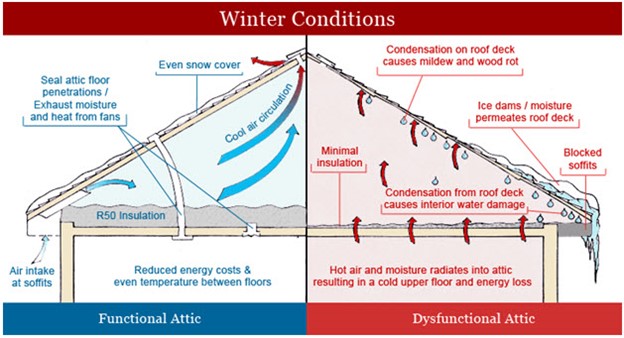
Attic Ventilation
The Main Purpose of Roof/Attic Ventilation
It might seem logical that if you’re going to spend time and expense to keep heat in, you don’t want cold air blowing into your attic through these vents, but believe me when I say that this is a mistake. Actually you want cold air blowing in the attic. When it is cold outside, the primary purpose of ventilation is to maintain a cold roof temperature to avoid ice dams created by melting snow and to vent any moisture that moves from the conditioned living space to the attic. In a warm season, the purpose of venting is to expel hot air from the roof and attic and to reduce the temperature in the building.
Proper roof venting helps protect your roof and home in two key ways;
- It brings fresh, cool air into the attic through the intake vents located under the eaves
- It releases hot, moisture-filled air from the exhaust vents at the ridge of the roof.
This keeps the attic air circulating and prevents the build-up of too much heat, even in summer, benefitting you in many ways.
Keep Your Utility Bills Down
In the summer, if there’s no air circulation, hot, stagnant air will build up under the roof, heating your ceilings and seeping into your living space, making the air-conditioning work harder and consume more energy.
Increase Your Roof's lifespan
If your attic gets overheated, your roof will be heated on its interior surface, in addition to the exterior one. This will cause the underlayment and then the shingles of your roof to dry out and crack much quicker than you’d expect, leading to expensive repair work.
Prevent moisture damage
In the winter especially, condensation can be a problem when warm air rises from the interior of your home and hits cold surfaces. If your attic isn’t properly ventilated this moisture will build-up, leading to mold, moisture stained ceilings, and even structural damage to the rafters, and trusses of the roof itself. If this problem isn’t spotted in time, it could necessitate a complete roof replacement.
Prevent ice dams from being formed
While they might look very picturesque, icicles hanging along the edges of the roof are not something a homeowner wants to see. They are a sign of ice dams, a problem commonly associated with a badly-ventilated attic. If your attic retains hot air rising from below and becomes too warm during winter, your roof will heat up. This will cause the snow on it to melt. The resulting water will flow down to the edge of the roof and gutter, where it’s considerably cooler, and refreeze, building up as the cycle is repeated with each new snowfall. In the end, water will back-up under the eaves and even into the attic.
As you can see, proper ventilation in your attic plays a vital role in preserving the integrity of your roof and protecting your home.
How To Know If The Roof Has Proper Ventilation?
Here are some steps to inspect your roof ventilation:
Touch your ceiling on a warm, sunny day. If your ceiling is hot, that tells you that the attic is acting like a solar oven. It is raising your cooling bills and should improve the ventilation of the roof.
Thick ridges of ice on your eaves or ice damming in winter are a sign of poor attic ventilation. The warm air that escapes the rooms below gets trapped in the attic. Snow melts and the water refreezes on the cold eaves, creating ice dams.
The warm air that escapes living space also carries moisture that will condense on rafters or roof sheathing. During the winter inspect your attic and look for dampness or frost. If you find any of those, it a clear signal that your roof needs better ventilation and some attic vents.
How you can help improve the ventilation in your attic?
First, take a look at your eaves and roof. If there are no attic vents on the roof or in the eaves, you should add some.
And consider adding a solar fan, which will reduce moisture which can help with mold and mildew, increasing the air exchanges per hour assists the passive venting which is currently in place. In the winter, solar fans help to prevent moist air from condensing on the underside of the roof, beams, and rafters. Condensation can cause mildew, rotting of wood, and excessive rusting of some components of the roof structure. Solar fans help keep the attic dry.
A quick, economical way to improve your ventilation is with a solar attic fan, they are the way to go, they require no other wiring, so they don’t cause any additional charges on your electricity bill at all, they are extremely quiet and the products that we use at Koala Insulation of Cincinnati are run by an internal thermostat and humidistat. In addition, they are guaranteed for life! And in 2022, the solar attic fan qualifies for a 26% federal tax credit.
Ready to book your free insulation evaluation?
We have 3 convienant ways for you to get in touch
We Provide Insulation Services to the Following Cincinnati Areas
CAMP DENNISON, MILFORD, TERRACE PARK, CINCINNATI, WEST CHESTER, FRANKLIN, LEBANON, MIDDLETOWN, MONROE, SPRINGBORO, TRENTON, KINGS MILLS, MAINEVILLE, MASON, SOUTH LEBANON, LOVELAND, MORROW
Counties Served
HAMILTON, CLERMONT, BUTLER, WARREN
Zip Code
45111, 45150, 45174, 45208, 45209, 45212, 45213, 45226, 45227, 45230, 45236, 45243, 45244, 45069, 45215, 45218, 45231, 45240, 45241, 45246, 45005, 45036, 45042, 45044, 45050, 45066, 45067, 45034, 45039, 45040, 45065, 45140, 45152, 45242, 45249
